At new year we took a 6-day trip to the Goto Islands, just off Kyushu. These are a bit off the regular tourist routes, but quite interesting historically, having been on the way in to Japan from the Asian continent, and also for the Christian population who fled there escaping persecution in the Edo era. As a result there are many churches, some of them quite beautiful, though not so old. The scenery is also stunning in places, especially the north. Anyway I’ll leave you to Google “Goto Islands” if you want to learn more, and just add a few notes from our own visit, and some photos.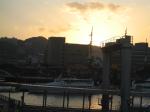
It’s a three-hour ferry ride from Nagasaki to the island of Fukue in the south. (The hydrofoil’s faster but more expensive.) It leaves in the morning so we fly to Nagasaki the evening before and stop at a business hotel.
It’s cold (January, remember) – don’t expect balmy sub-tropical Okinawa. We’re fairly north here and Korea’s not far away, though the Kuroshio current does warm the sea a bit. On the first of January it snowed in Fukue and there was still some on the ground in patches when we arrived on the 2nd. On the 3rd we had a bitter cold wind. Generally it was cloudy with occasional sun which did warm things up if you were out of the wind. They get a lot of wind here. Occasional gaps in the clouds which let through dramatic rays of sun also seem a feature which fits in nicely with the Spiritual imagery. (Most visitors come in summer.)
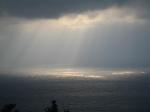 Public money has been spent here: there are many bridges and tunnels, and the ferry terminals are warm, spacious, shiny and super-clean. (Use the toilet there while you have the chance.) The northern Kami-Goto area has its own smart airport which now looks out of use. Still, off the nice new main roads you have these narrow twisty lanes with many hairpin bends that lead to tiny fishing villages with even narrower streets. There are buses, but you’ll probably need a car to get around so make sure you rent a little one, especially away from Fukue island. The islands are bigger than you might think. You’d need a couple of weeks to cycle around so a car is pretty much essential – rent is around ¥4500 a day.
Public money has been spent here: there are many bridges and tunnels, and the ferry terminals are warm, spacious, shiny and super-clean. (Use the toilet there while you have the chance.) The northern Kami-Goto area has its own smart airport which now looks out of use. Still, off the nice new main roads you have these narrow twisty lanes with many hairpin bends that lead to tiny fishing villages with even narrower streets. There are buses, but you’ll probably need a car to get around so make sure you rent a little one, especially away from Fukue island. The islands are bigger than you might think. You’d need a couple of weeks to cycle around so a car is pretty much essential – rent is around ¥4500 a day.
Many shops, museums etc. are closed till 4th January – be careful travelling at new year. Fukue has seen better days. Arakawa hot spring (where we stayed two nights) obviously used to jump – there are many bars and ryokan now closed, leaving just two ryokan and two minshuku, all pretty run-down looking. It was the whaling apparently, and the fact that Arakawa was a refuge for fishing boats when the weather was bad, so the sailors would drop some of their (relatively good) pay there. This all ended some 30 years ago. Our ryokan is in an 80-year-old wooden building which is full of character but in need of repair in many places. The dinner is pretty good though, with an abundance of locally caught fish.
Many Group Homes for the elderly – there seems to be another one on every corner. At first we thought it was good service by the local government, but later heard they’re all privately run. The aging population must mean there’s a good market.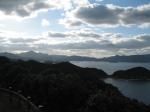
Moving north to Kami-Goto for three more nights – these islands are very mountainous and incredibly complicated with oddly shaped inlets and peninsulas (check Google Maps). You get amazing scenic views at every corner. It must be gorgeous – verging on breathtaking – in summer. The water is crystal clear, so you can see right down to the bottom, just like Okinawa. Somehow I like the atmosphere here in the North more than Fukue – it seems a bit livelier.
Our minshuku here “Katayama” is in a little fishing village like dozens of others we pass on our first day, though maybe a bit scruffier than some. Old fishing nets used as fences. Katayama is at the end of a decrepid wharf but the house itself is a typical Japanese wooden farmhouse, ie rather nice, and the lady who runs the place (Mrs. Katayama?) keeps it very clean and pleasant, decorated with flowers and her own patchwork. A very friendly, positive, person who clearly takes a personal interest in her guests. 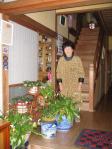 She cooks good food too, mostly based on vegetables she grows herself and fish from the port down the road. For example, dinner on Saturday night was buri teriyaki, tofu, oden with delicious daikon, carrot and home-made konnyaku, four kinds of sashimi followed by freshly made tempura then rice, pickles and soup with sea bream head. I may have forgotten something. Everything was good.
She cooks good food too, mostly based on vegetables she grows herself and fish from the port down the road. For example, dinner on Saturday night was buri teriyaki, tofu, oden with delicious daikon, carrot and home-made konnyaku, four kinds of sashimi followed by freshly made tempura then rice, pickles and soup with sea bream head. I may have forgotten something. Everything was good.
There are camelias everywhere, especially on the northern Nakadori island. The oil used to be an important local product but now apart from tourist souvenirs it seems to be mostly used in the rather special local noodles “Goto udon”. They are slimmer than standard Japanese udon noodles with a pleasant smooth texture and come in a broth made from dried flying fish, called “ago dashi”. Quite good actually.
The crime rate is obviously low. Our rented car is waiting at the ferry terminal in Nakadori, unlocked, with the key in the ignition! “Come to the office to pay any time you like” they said.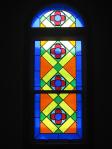
There really are a lot of churches here, especially in the North, often standing above a tiny village at the end of one of those twisty back roads. I think the current overall Christian population of the Goto islands is around 20%, but in some of the outlying villages it’s more like 95%, which is certainly unusual for Japan. None of the churches are much more than 100 years old, because Christianity was strictly forbidden, and very cruelly repressed, during the Edo period. Some are quite modern, but most are very simple in design, often plain white, with equally simple interiors that feel more Protestant than Catholic. Much more than when visiting temples or shrines, I feel as if I might be intruding in someone’s private space.
When we switch on the car ignition a little panel on the dashboard reads “Hello Happy” and when we open the door to get out it says “See you, good-by.”
We drive up to the top of Nakadori Island, via numerous churches, up a narrow neck of land that’s more like a submerged mountain chain, to the lookout point at Tsuwazaki, where you can look out over a stretch of sea studded with dozens more islands. I can see smoke coming from behind a hill on one of them. That evening the TV news mentioned a fire in the area…
The next day, to Hinojima, over a couple of big bridges, way over to the west. There’s a little village there, now half-deserted, with a beautiful 100-year-old school building that’s now used, if at all, for summer camps or something. With a couple of broken windows, it definitely needs some care and attention, which it won’t necessarily be getting… Just behind are a rather nice temple and shrine. The temple, Genju-in (源寿院) has a Buddha image, several hundred years old, which is only displayed every 33 years. It was originally pulled from the sea in a fishing net!! Could it have drifted over from Korea?
 Back in Nagasaki with a couple of hours before we have to head to the airport, we sip a glass of wine on Dejima wharf and enjoy the lights of the harbour as the day draws to an end. While it’s not exactly warm, it is (just) feasible to sit outside, which is not at all the case in Nagoya at the moment. What I like about eating in Japan – even in touristy spots like this there’s no service charge, no added tax, and no tipping. Four drinks at 500 yen each, one pizza at 1050 yen, total 3050 yen. That’s it. (Nagasaki‘s a very nice place, and well worth a visit in itself in warmer seasons.)
Back in Nagasaki with a couple of hours before we have to head to the airport, we sip a glass of wine on Dejima wharf and enjoy the lights of the harbour as the day draws to an end. While it’s not exactly warm, it is (just) feasible to sit outside, which is not at all the case in Nagoya at the moment. What I like about eating in Japan – even in touristy spots like this there’s no service charge, no added tax, and no tipping. Four drinks at 500 yen each, one pizza at 1050 yen, total 3050 yen. That’s it. (Nagasaki‘s a very nice place, and well worth a visit in itself in warmer seasons.)
I took a lot of photos. You’ll soon get the somewhat grey atmosphere, but even in winter weather it was a good trip.






































































































[…] soon after Chrisianity was permitted, in a similar style to the older churches we had seen on the Goto Islands. The next day I went back and took some […]